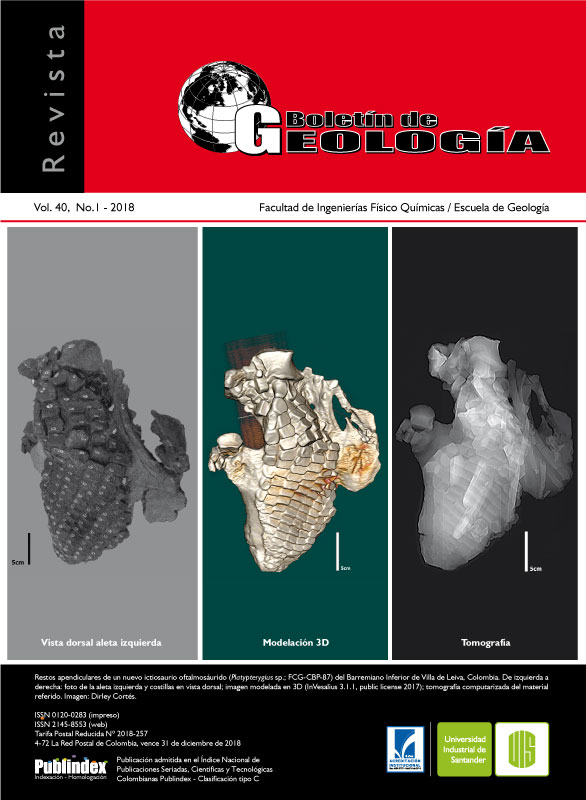Explosibility risk evaluation of the methane gas in coal underground mining, case Sinifaná basin, Colombia
Published 2018-02-23
Keywords
- methane,
- digging,
- coal,
- Sinifaná
How to Cite
Altmetrics
Abstract
Coal-Bed Methane (CBM) has the risk to generate explosions when its volume is between 5% and 15%, so it is very important to perform a routine monitoring of its concentrations during mining activities. The most critical point of the coal mining is the digging because it is the moment when the perturbation of CBM occurs, causing its release. Were performed measurements of methane concentrations during the digging in mines along the Sinifaná basin, from wich were performed profiles and correlations to determine the most influential factors for gas accumulations and explosions. Also, they were performed correlations between factors of ventilation and geographical locations of the mines, being the first the most influential it presenting concentrations of 30% higher in mines without ventilation.
Downloads
References
Anna, L.O. (2003). Groundwater flow associated with coalbed gas production, Ferron Sandstone, east-central Utah. International Journal of Coal Geology, 56(1-2), 69-95. doi: 10.1016/S0166-5162(03)00077-6.
ATEX 100. Directiva de aparatos y sistemas de protección contra atmósferas explosivas. 1996.
ATEX 137. Protección de la seguridad y la salud de los trabajadores expuestos a los riesgos derivados de la presencia de atmósferas explosivas en el lugar
de trabajo. 1999.
Charris, T. (2013). Resumen de ideas en la aplicación de la ingeniería total en una mina de carbón, con protocolos y normas para minas de carbón, en especial minas grisúgenas. Consultado el 2 de febrero de 2017. http://www.fedecundi.com/empresarioseingenieros.pdf.
Clavijo, J.A. (2016). Monitoreo de gases en minería. Instrumentación especializada higiene y seguridad. Agencia Nacional de Minería. Consultado el 16
de noviembre de 2016. http://www.anm.gov.co/sites/default/files/DocumentosAnm/presentacion_multidetectores_ibrid-mx6.pdf.
Crowcon. (2017). Crowcon Detective +. Consultado el 28 febrero 2017. https://www.crowcon.com/uk/products/portables/detective-plus.html.
Fernández, C., García, J., y Vega, A. (2003). Breve guía sobre productos e instalaciones en atmosferas explosivas. Madrid: Laboratorio oficial J.M. Madariaga.
Flores, R.M., Rice, C.A., Stricker, G.D., Warden, A., and Ellis, M.S. (2008). Methanogenic pathways of coal-bed gas in the Powder River Basin, United States: The Geologic factor. International Journal of Coal Geology, 76(1-2), 52-75. doi: 10.1016/j.coal.2008.02.005.
Hackley, P.C., Warwick, P.D., and Breland Jr, F.C. (2007). Organic petrology and coalbed gas content, Wilcox Group (Paleocene–Eocene), Northern Louisiana. International Journal of Coal Geology, 71(1), 54-71. doi: 10.1016/j.coal.2006.05.009.
Instituto Nacional de Seguridad e Higiene en el Trabajo (2003). Atmósferas explosivas en el lugar de trabajo. España. Consultado el 16 de noviembre de 2016. http://www.insht.es/InshtWeb/Contenidos/Normativa/GuiasTecnicas/Ficheros/ATM%C3%93SFERAS%20EXPLOSIVAS.pdf.
Islam, M.R., and Hayashi, D. (2008). Geology and coal bed methane resource potential of the Gondwana Barapukuria coal basin, Dinajpur, Bangladesh.
International Journal of Coal Geology, 75(3), 127-143.
Karacan, C.Ö., Ruiz, F.A., Cotè, M., and Phipps, S. (2011). Coal mine methane: A review of capture and utilization practices with benefits to mining safety and to greenhouse gas reduction. International Journal of Coal Geology, 86(2-3), 121-156. doi: 10.1016/j.coal.2011.02.009.
Laubach, S.E., Marrett, R.A., Olson, J.E., and Scott, A.R. (1998). Characteristics and origins of coal cleat: A review. International Journal of Coal Geology, 35(1-4), 175-207. doi: 10.1016/S0166-5162(97)00012-8.
Moore, T.A. (2012). Coalbed methane: A review. International Journal of Coal Geology, 101, 36-81. doi: 10.1016/j.coal.2012.05.011.
NFPA 122. (2015). Standard for Fire Prevention and Control in Metal/Nonmetal Mining and Metal Mineral Processing Facilities. National Fire Protection Association.
Seidle, J. (2011). Fundamentals of coalbed methane reservoir engineering. Chap. 3. Geologic aspects of coal gas reservoir engineering (pp. 59-88). Oklahoma: PennWell Books.
Shi, J.Q., Durucan, S., and Sinka, I.C. (2002). Key parameters controlling coalbed methane cavity well performance. International Journal of Coal Geology, 49(1), 19-31. doi: 10.1016/S0166-5162(01)00054-4.
Thauer, R.K., and Shima, S. (2006). Biogeochemistry: Methane and microbes. Nature, 440(7086), 878-879. doi: 10.1038/440878a.

